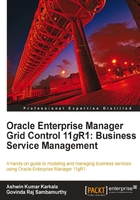
Oracle Enterprise Manager concepts
OEM is a software offered by Oracle that provides a single unified platform for modeling and managing enterprise data centers. Although targeted primarily towards managing the Oracle suite of products within an enterprise, it also has built-in capabilities to model and manage a limited set of widely adopted non-Oracle software products. It provides comprehensive monitoring and management capabilities for the entire Oracle Grid within the enterprise. It covers all aspects of the Oracle stack starting from the physical host management to database management. It also includes management for Oracle middleware components and the applications running on it. As discussed in the previous chapter, the mindset of IT executives has shifted more towards business enablement using IT infrastructure rather than just IT operations management. However, the shift in focus does not mean that IT operations can be ignored. In fact, companies are now keen to understand the impact of IT operations on their business service offerings.
Therefore, in the current context, an enterprise-wide IT infrastructure management product must be able to provide modeling and management functionalities for business services, along with excellent capabilities around the management of the day-to-day IT operations. OEM is one of the few products that provides complete capabilities around service modeling as well as tools to assess the impact of IT operations on the business service.
Let's now look at some of the key features provided by OEM. OEM provides discovery, monitoring, and management of various pieces of the IT infrastructure. Each of the pieces or entities that need to be monitored and managed is known in the OEM parlance as a target. The above features provide the foundation for the rich set of management capabilities offered by OEM. Therefore, prior to proceeding any further, let's take a cursory look at these features:
- Target discovery: It involves finding, mapping, and then modeling a physical or logical entity in the IT infrastructure in OEM. Each of these entities that are part of the IT infrastructure must be modeled in OEM as one or more targets. The discovery part begins with finding the entity, then mapping it to a particular OEM type, and it ends with the creation of the actual target instance within OEM.
- Target monitoring: It revolves around providing an insight into the basic functioning of the target. For example, target monitoring essentially provides the answer to the administrator's question: "Is the target up, and if so is it performing as well as we expect it to?"
- Target management: It revolves around performing active changes to either the current process status or the configuration of the target. As an example, changing the status of a target process might involve stopping a current process related to the target (or the entire target itself). Similarly, as an example, changes to the configuration might involve changing the number of simultaneous user requests a server might have to handle.
As discussed in Chapter 1, target modeling and monitoring is the base on which other models can be designed. These higher level models are important and allow administrators to aggregate individual targets into buckets that are more aligned with the business. These buckets are also OEM targets in their own right and are modeled as such. These aggregate targets now allow OEM developers and integrators to build higher level features and capabilities that allow mapping of business priorities onto the IT infrastructure. These aggregate targets are of three main types:
- Group: A group target is a collection of individual targets of the same type. This aggregation is intended to provide a mechanism to monitor and manage targets of the same type. A typical example of such an implementation is a database group. A DBA might be responsible for all the databases within such a group. The group target now presents the administrator with a view of all the databases of concern.
- System: A system target is a collection of individual targets that form the base for providing a business service. While the group target can be viewed as more of a physical aggregation, the system target is intended to provide a functional one. An example of a system target is a website. This system will include disparate targets that are involved as part of the hosting website.
- Service: A service target is a logical target and more often than not, represents the end user functional view of the IT infrastructure. The service model is the one closest to the business view and is used to represent the business functionality provided by the underlying infrastructure. It is therefore the target most likely used to map and subsequently track business priorities. An example of a service target is user authentication service. This service maps to the functional business service of providing user authentication. It might be modeled on an underlying authentication system that represents the physical infrastructure used to provide the functionality. The service target provides a mapping of the business function to the physical infrastructure.
These are very brief examples that are intended to introduce some of the concepts in OEM. A more detailed introduction and a deeper dive into these concepts are provided later in this chapter and also throughout the book.